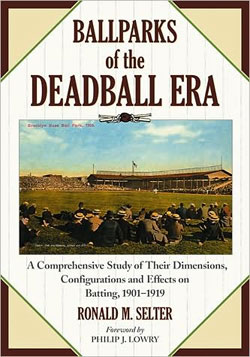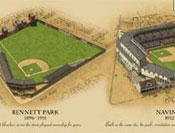
|
 Burns Park was a ballpark used by the Detroit Tigers for Sunday games in the 1901 and 1902 seasons. The all-wooden ballpark was located in the Michigan township of Springwells, a small township that in 1901 was located just west of the Detroit city limits. The park’s location was on Dix Street, a street that in 2006 runs at an angle mostly east-west, between Waterman Street and Livernois Avenue, both of which ran north-south (1). The problem with this described location is that in 2006 there were four blocks between Waterman Street and Livernois Avenue. This location in 2006 is now in the southwest portion of the city of Detroit.
Burns Park was a ballpark used by the Detroit Tigers for Sunday games in the 1901 and 1902 seasons. The all-wooden ballpark was located in the Michigan township of Springwells, a small township that in 1901 was located just west of the Detroit city limits. The park’s location was on Dix Street, a street that in 2006 runs at an angle mostly east-west, between Waterman Street and Livernois Avenue, both of which ran north-south (1). The problem with this described location is that in 2006 there were four blocks between Waterman Street and Livernois Avenue. This location in 2006 is now in the southwest portion of the city of Detroit.
The park was built before the 1900 season for the purpose of playing Sunday baseball games by the (then minor league) Detroit Tigers. The park was used for Sunday games because Sunday baseball was prohibited in Detroit until 1907. Burns Park was built on land owned by the then (1900-1901) owner of the Tigers, James D. Burns, who named the park after himself. Burns Park was an all-wooden ballpark that had been quickly constructed. The structural strength of the park can be judged from an incident early in the 1901 season. On April 20, 1901, a wind blew the roof of the grandstand onto the field. The park was opened on May 6, 1900 when it was first used for a minor league game by the AL Detroit Tigers (in 1900 the AL was a minor league). On Opening Day 1900 the park consisted of a grandstand with a seating capacity of about 3,000. On Opening Day, and at several other Sunday games that season, there were unruly overflow crowds. During the 1900 season the grandstand was expanded. This expansion proved inadequate and a set of bleachers 160 feet long were built in May 1901 down the RF line. This expansion eliminated most overflow crowds. Opening Day 1901 drew over 10,000 fans, including an overflow crowd in the outfield. In 1901, with the AL now a self-proclaimed major league circuit, the Tigers played 13 Sunday games at Burns Park. During the 1902 season additional bleachers were built that permitted the outfield to be clear of spectators (2). Continuing to use Burns Park for Sunday games, the Tigers played an additional 10 Sunday games in the 1902 season to avoid the Blue Laws in Detroit regarding Sunday baseball. The Sunday games at Burns Park were a popular success. Attendance in 1901 averaged 5,208 per game vs. 3,364 for non-Sunday games at the regular Detroit home park, Bennett Park. Likewise in 1902 attendance averaged 4,473 per game at Burns Park vs. 2,539 for games at Bennett Park. However, the park suffered from being in an unsavory area -- both stockyards and numerous saloons were nearby. After forcing a sale of the club after the 1901 season, the AL (which in that time period meant effectively the AL President Ban Johnson) put pressure on the new Tigers ownership to cease the use of Burns Park as the AL sought an improved image for the AL and baseball in general vs. the rowdy, liquor-laden, fight-prone crowds at Burns Park. While the moral reputation of the park was none too good, AL hitters certainly thought highly of the park. Burns Park posted run park factors of 137 and 172 in its two seasons of major league baseball.
There is also no available dimensional data for this ballpark. In a 1902 game account there was a reference to a home run over the scoreboard and inside of the LF foul pole (2). This established that there was a scoreboard in LF not far from the LF corner. Based on the batting data, and in particular the home run data, LF was most likely small, while CF and RF were more moderate sized. Estimates of the average outfield distances are LF 305-315, CF 380-390, RF 355-365. The CF and RF estimates are merely guesses. The LF dimensions are based on comparisons of the Burns home run data to the home run data for other 1901-02 AL parks. Thus the park size is unknown, but inferred from the batting data as most likely small. The less than specific location of this park, the total absence of park photos, and the lack of any Sanborn map makes the park’s dimensions and the overall park size simply informed estimates or guesses. From comparisons of home run data, the LF fence was rather close, about like the short LF fence at the 1901-03 Washington Senators home park (AL Park I) that had a LF foul line distance of about 290 and an average LF distance of 317. Home run data for Washington’s AL Park I in 1901-02 show Over-The-Fence (OTF) home runs to LF to have been 88 in 136 games, a rate of 0.65/game. At Burns Park the OTF home runs/game to LF range were at a minimum of 0.74/game (17 home runs known in 23 games). This home run data suggest the average LF distance at Burns Park was roughly the same as at AL Park I -- about 310-315. Logically the average distances for CF and RF must have been greater than for LF. There were no Inside-the-Park Home Runs (IPHR) at Burns Park in either 1901 or 1902. By comparison, at Washington’s AL Park I that had similar LF dimensions, IPHR accounted for 20% of total home runs in the same two seasons. The assumed Burns Park configuration is with the LF and RF fences at 90 degrees to the foul lines, and a CF diagonal fence. Based on this assumed configuration and dimensions of LF 295, CF 390, and RF 340, a park diagram was developed. Park data, and dimensions, for Burns Park are shown below:
Dimensions (All Estimated from Park Diagram)
Average Outfield Distances (All Estimated)
The exceptional Burns Park batting averages posted by the Tigers in these two seasons were helped by two other environmental factors. First, for the 1901 and 1902 seasons the AL had not yet adopted the foul strike rule. Thus in 1901-02 in the AL (but not in the NL) foul batted balls were not strikes. A comparison of batting averages before and after the AL adoption of the foul strike rule (starting with the 1903 season) indicates that the deferred adoption of this rule increased averages in the AL in these two seasons by 15-20 points. Second, the AL as a whole in 1901-04 had very high levels of home park advantage as the league batting average those seasons was 24 points higher (nearly 10% more) in home games vs. road games. To correct for this second factor the author has included the batting data for the Tigers’ opponents. Even with the inclusion of the visitor’s batting data the impression of Burns Park as a hitter’s delight is still striking. In the 23 games played at Burns Park in its two seasons of Sundays only baseball, 19 home runs were hit. This amounted to a rate of 11.2 home runs per 100 at bats, or more than three times the rate of home runs at the main Detroit home field (Bennett Park). Of these 19, 18 are known to have been Over-The-Fence (OTF) home runs. One home run could not be confirmed as OTF. That home run was hit by a right-handed batter and likely an OTF home run to LF. Of the total of 18 known OTF home runs, one was hit over the CF fence, and all of the other 17 home runs were hit over the LF fence. Burns Park was a very good park for average, on-base, slugging, doubles, and home runs; but a below average park for triples. The high park factors for doubles and home runs along with the low park factor for triples are consistent with the estimated dimensions and average outfield distances shown in the tables above. Compared to Bennett Park, the main Detroit ballpark, Burns Park was a far better offensive ballpark, particularly for home runs, as shown below by the table of batting park factors:
Batting Park Factors (Average of 1901 and 1902):
1 Richard Bak, A Place For Summer, Detroit MI, Wayne State University Press 1998 2 Detroit Free Press, May 19, 1902 3 Bak, Richard, Charles Vincent and the Detroit Free Press Press Staff, The Corner, Chicago IL, Detroit Free Press/ Triumph Books 1999
Excerpted from Ballparks of the Deadball Era by Ron Selter © 2008.
| ||||||||||||||||||||||||||||||||||||||||||||||||||||


